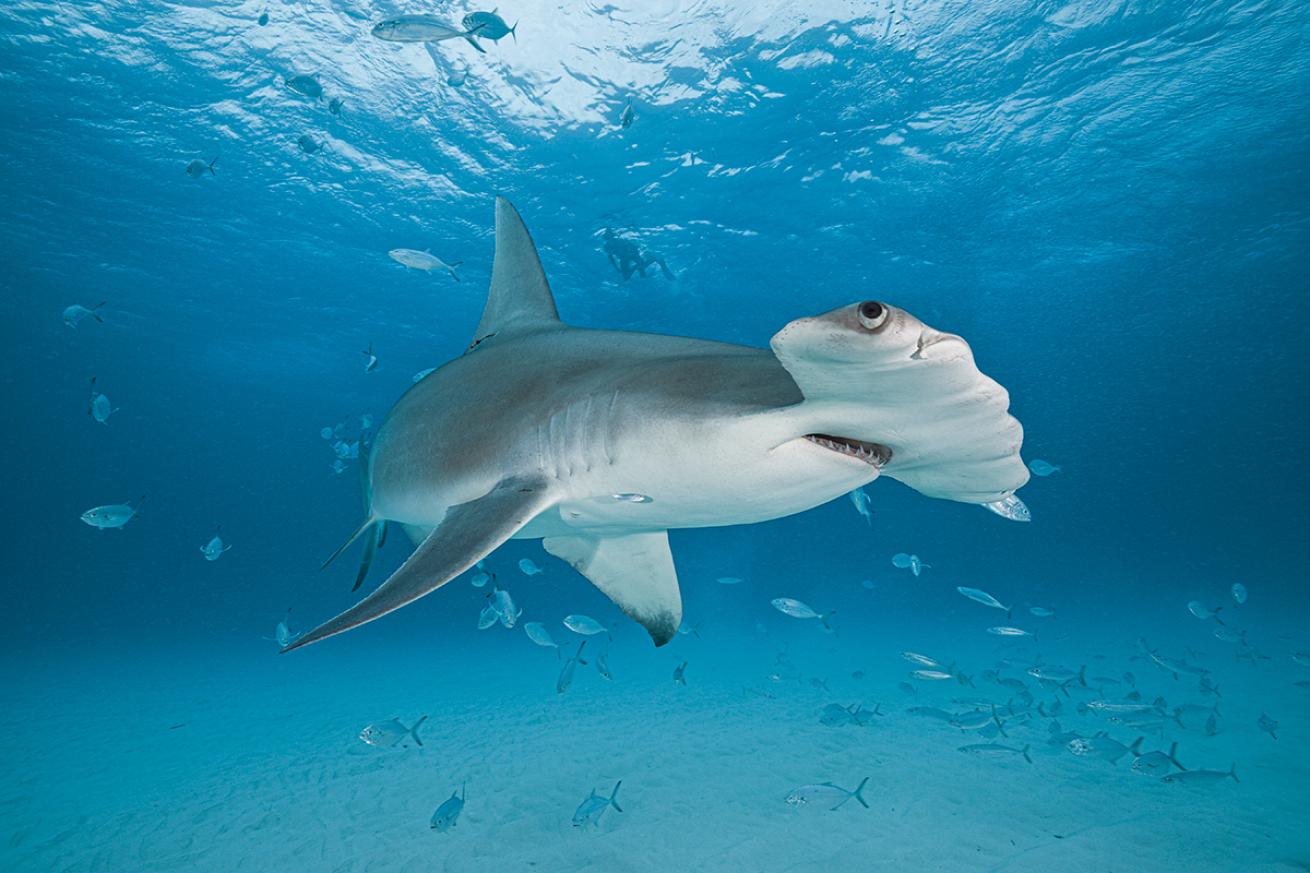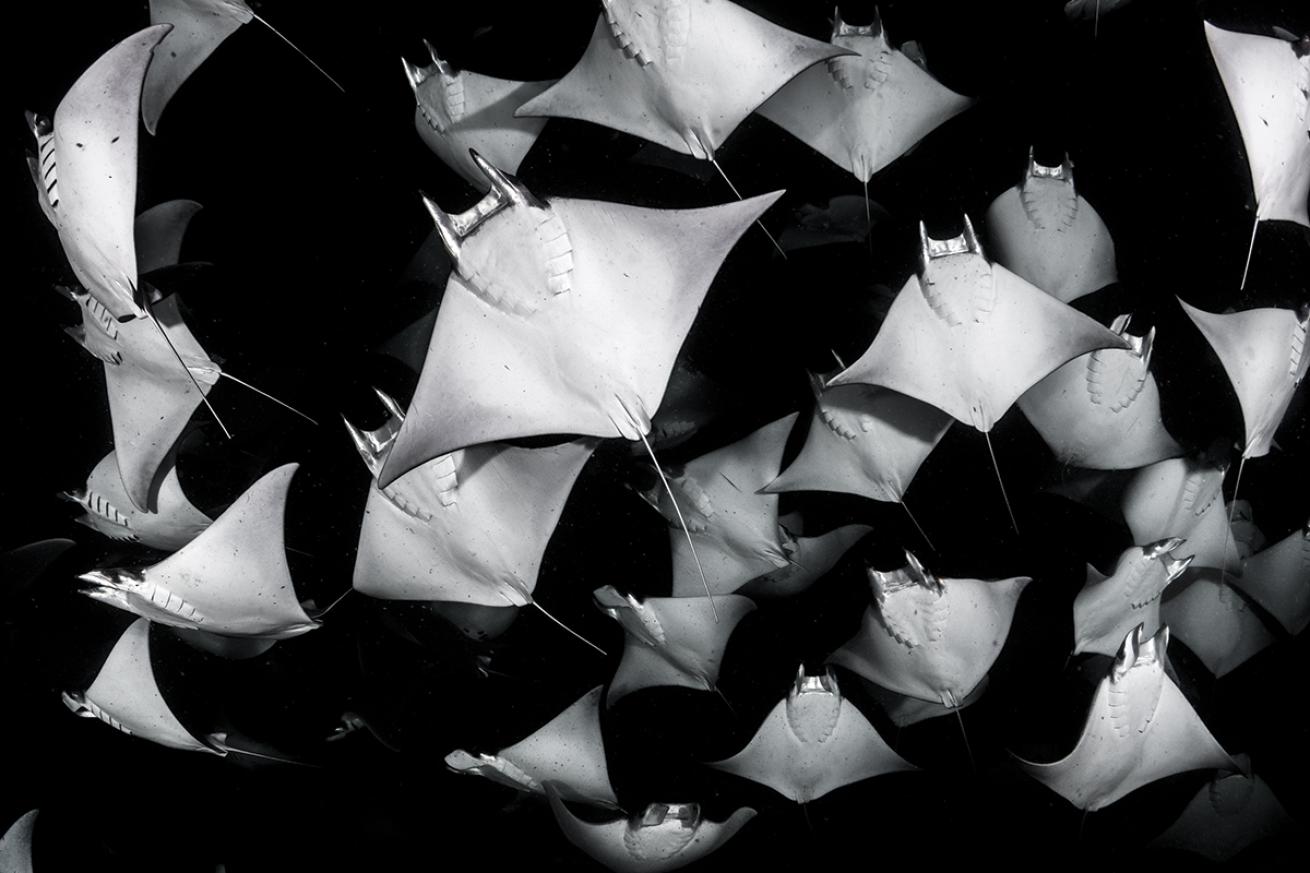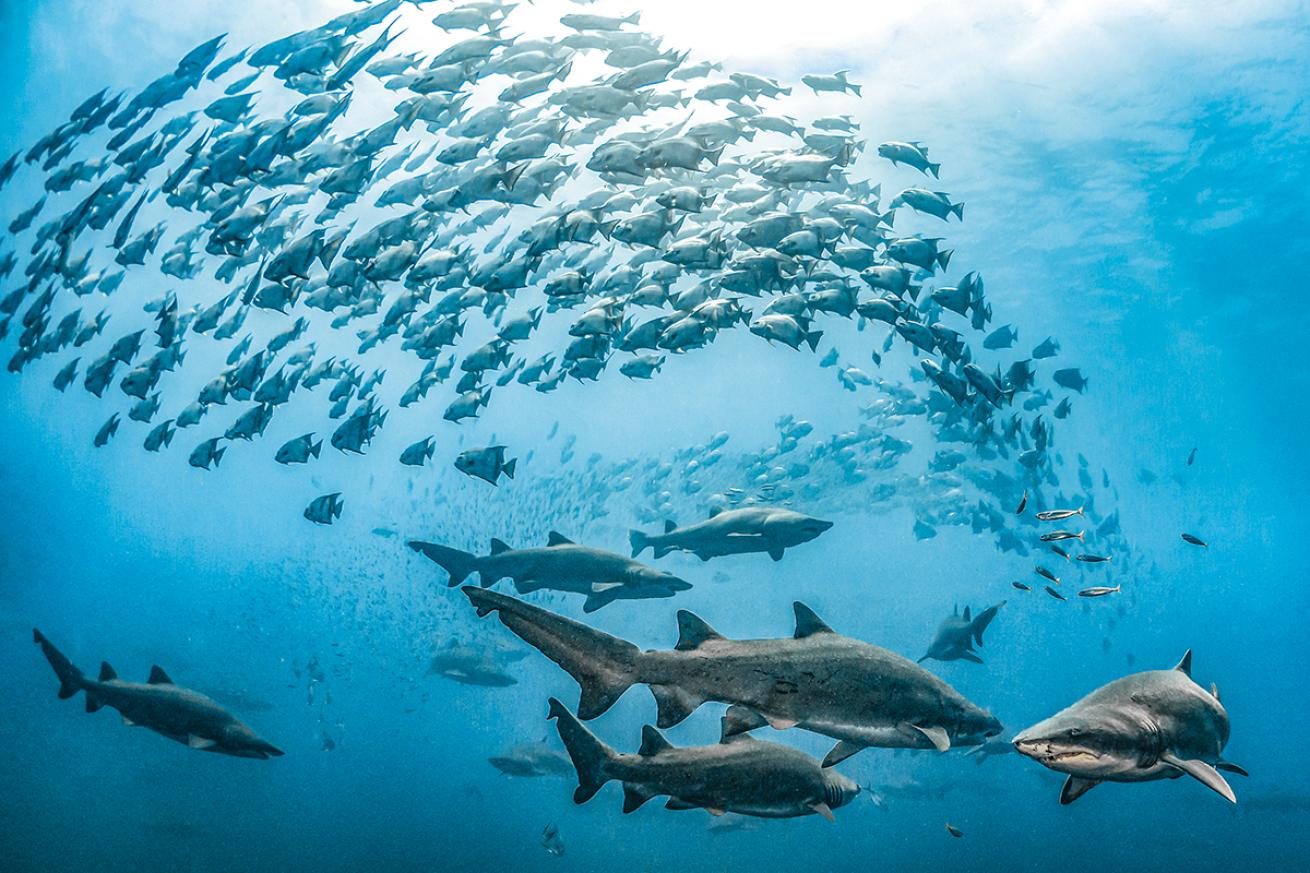The Best Places to Dive with Big Animals in 2021
Sharks, whales, mantas and dolphins bring the excitement to the dive locales voted by Scuba Diving magazine’s readers as the greatest places to seek big animal encounters.
1. The Bahamas

Brandon ColeA great hammerhead prowls above a sandy bottom in the Bahamas, which banned shark fishing almost a decade ago.
The islands of the Bahamas are among the most shark-rich in the region thanks to 1993 regulations prohibiting longline fishing. In 2011, the country further moved to ban shark fishing nationwide. Moreover, this destination was one of the first to fully recognize the value of a living reef shark—a quarter of a million dollars in tourism revenue over the course of a lifetime, according to some estimates.
“You’re going to see Caribbean reef sharks on almost every dive,” says Kevin Purdy of All Star Liveaboards about the Exumas, where his company operates four liveaboard vessels. Hammerhead sightings are also likely in the Exuma chain of islands, which stretch south of Nassau. “When you head to deep water, you see them down in the blue just cruising,” says Purdy.
One unique place to see schooling sharks is the Lost Blue Hole between Nassau and the Exuma Cays, visited each week by the various All Star vessels. May to July, a hundred blacknose sharks—a smaller species at 3 to 4 feet in length— congregate to mate, creating a funnel of fins and activity.
READERS PICKS
Operators
Stuart Cove’s Dive Bahamas, New Providence
Liveaboards
Aqua Cat, Bahamas
Bahamas Aggressor, Blackbeard’s Cruises, Bahamas
Cat Ppalu, Bahamas
2. Palau
Blue Corner and Peleliu Express are the two standout sites for divers seeking big action in Palau. Guides time entry with the strongest tidal currents so that guests can keep up with gray and whitetip reef sharks, as well as the occasional bull shark and hammerhead. The trick is the hook—a curl of metal that divers wedge into the substrate before unwinding a few feet of rope, tethering them in place as the water rips past. The method works well, giving divers long encounters with these predators, which also enjoy the conditions that allow them to more or less stay in place, letting the current rake water over their gills—thus removing much of the need for constant swimming.
Another big highlight of Palau is the population of Napoleon wrasse, which show up on most tours to check out divers. Sharks don’t often display curiosity toward humans, but Napoleon wrasse will beeline toward a swimmer’s bubble stream, perhaps believing it to be spawn. Regardless of why they appear, their presence is always a treat. Where sharks evoke awe and perhaps intimidation, these googly-eyed goofs offer underwater comic relief.
READERS PICKS
Resorts
Palau Pacific Resort
Operators
Fish ‘n Fins, Palau Sam’s Tours, Palau
Liveaboards
Ocean Hunter I & II, Palau Palau Aggressor II
3. Mexico

Jason SintekMobula rays show up on a night dive in Mexico's Sea of Cortez.
The town of Loreto, located a four-hour car ride north of La Paz on the Baja Peninsula, is famous for being one of just a handful of places in the world where, February through March, travelers can reliably see blue whales. However, the sanctuary that is Loreto Bay National Marine Park does not allow divers or snorkelers in the water with these whales, the largest mammals on the planet.
What travelers can experience in the water are the schools of mobula and bat rays that cruise the area April through July. “It’s a good show when you go to the dive site—they’re often jumping out of the water,” says Rafael Murillo, assistant instructor with Dolphin Dive in Loreto. Murillo has swum with fevers of rays numbering from a few dozen to hundreds— and even up to a thousand— at a time. So how many rays can the typical visitor expect? “Every season is different,” Murillo says.
The animals come to feed on the plankton blooms, which reduce visibility to around 30 feet. Although divers can swim with the rays, Murillo finds it is a much better experience when freediving, which allows one to keep pace with the animals for a longer—and more memorable— experience.
READERS PICKS
Liveaboards
Nautilus Explorer, Mexico
Rocio Del Mar, Baja, Mexico
4. Hawaii
We have a catalog of them,” says Jack’s Diving Locker’s Teri Leicher of all the identified mantas known to show up to the night dives off the west coast of the Big Island, near the town of Keauhou.
The Big Island is unique in this way, not only that it delivers almost surething encounters with this megafauna species at a site just 35 feet deep, but also because guides such as Leicher know these individuals by name. She has been guiding the dive for more than 25 years, and has logged thousands of hours at the site, getting to know the regulars, most of which are residential, and how to identify them. Many of the regulars, including Lefty, so named for a broken left head fin—aren’t going anywhere. “We’ve known Lefty longer than we have known our own children,” Leicher says.
READERS PICKS
Operators
Big Island Divers, Hawaii Dive Maui, Hawaii
Dive Oahu, Hawaii
Jack’s Diving Locker, Hawaii
Kona Diving Company, Hawaii
Kona Honu Divers, Hawaii
Maui Dive Shop, Hawaii
Maui Diving Scuba Center, Hawaii
Maui Dreams Dive Co., Hawaii
Scuba Shack, Maui, Hawaii
Seasport Divers, Kauai, Hawaii
Liveaboards
Kona Aggressor II, Hawaii
5. North Carolina

Tanya HouppermansA group of sand tiger sharks congregates above the Caribsea off the coast of North Carolina.
Don’t panic if you’re diving the Caribsea wreck off the coast of North Carolina and it suddenly gets dark. Very dark.
“We had a group of divers on the bow of the Caribsea and they told us that the sun was blocked out—there was nothing but a wall of sharks,” says Tim Johnson, manager of Discovery Diving in Beaufort.
The sharks he’s referring to are sand tiger sharks, copper in color, with golden eyes and rows of teeth curled inward, like fingers beckoning. “They get closer than any other shark species,” Johnson says.
As for why that is, no one knows for sure. “They’re like any other wild animal,” he says. “If they’re around humans enough, they’re going to get used to them.”
The sharks show no signs of disturbance when divers arrive, as they have regularly for decades. Of course, sharks greatly outnumber the divers, with an average of 20 to 30 on the Caribsea in the summer months. In winter, the sharks still congregate in the area, but in smaller numbers of six to eight at a time.
6. Costa Rica
Scalloped hammerheads are the big draw of Costa Rica’s Cocos Island, 342 miles from mainland Central America. This destination, along with Colombia’s Malpelo Island and the Galapagos Islands of Ecuador, is part of the Golden Triangle, where this species is seen year-round. “If you go to Cocos and don’t see a hammerhead, it’s because you probably went to the wrong island,” says Alan Steenstrup, manager of Undersea Hunter, a liveaboard visiting Cocos year-round for weeklong trips.
But hammerheads are only a part of the picture. Another 13 shark species, along with humpback whales, manta rays and dolphins, are commonly sighted. At some sites, divers will see several megafauna species on one dive. For example, the cleaning station at Dirty Rock draws in a lot of action. “You’ll typically see at least a few hammers, but I was there once and started counting—10, 20—and then just added a zero to my count as there were that many. They just kept coming. It was a wall of hammers, and then here comes a whale shark breaking through that wall.”
READERS PICKS
Operators
Rich Coast Diving, Guanacaste, Costa Rica
Liveaboards
Undersea Hunter, Cocos, Costa Rica










